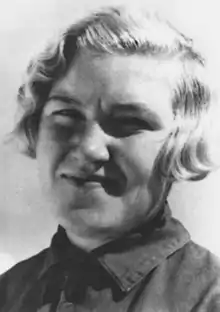Yevgeniya Prokhorova
Yevgeniya Filippovna Prokhorova (Russian: Евгения Филипповна Прохорова; 17 November 1912 – 3 December 1942) was a Soviet aviator who briefly served as the acting commander of the 586th Fighter Regiment before she was killed in action during World War II. She is still the record holder of a World Record in height gain for a single-place glider.
Yevgeniya Prokhorova | |
|---|---|
 | |
| Native name | Евгения Филипповна Прохорова |
| Born | 17 November 1912 |
| Died | 3 December 1942 (aged 30) |
| Allegiance | |
| Service/ | |
| Rank | Senior lieutenant |
| Unit | 586th Fighter Aviation Regiment |
Biography
Prokhorova was born on 17 November 1912 in Znamianka, Kirovohrad Oblast in what is now Ukraine. After graduating from school in 1932, she moved to Moscow and in 1934 was part of a flying club. In 1935, she qualified as a flight instructor and by the following year was instructing at the flying club in the Stalin District of Moscow.[1] Before the war, Prokhorova often participated in airshows as part of a quintet of women flyers.[2] In 1940, she established two flight records, one for range and one for altitude in her Rot Front-7 single-place class D glider.[1] Her altitude record for gaining 3,385 m at the airfield in Tula on 26 June 1940 still stands as a world record.[3]
In May 1941, Prokhorova was appointed commander of the Kirov flying club in Moscow and she joined the Academy of the Civil Air Fleet. She was commissioned as a pilot of the fighter regiment and served as acting commander of the 586th Fighter Aviation Regiment from December 1941 to March 1942. She died on an escort mission on 3 December 1942. Flying in fog, she hit the crest of a hill[1] as she attempted to land on the return mission.[4]
References
- "Прохорова Евгения Филипповна (1912-1942)" (in Russian). Letunij Narod. Retrieved 22 October 2015.
- Vinogradova 2015, p. 44-45.
- "List of records established by 'Evguenia PROKHOROVA (USSR)". Lausanne, France: Fédération Aéronautique Internationale. Archived from the original on 28 November 2004. Retrieved 22 October 2015.
- Noggle & White 2001, p. 216.
Sources
- Noggle, Anne; White, Christine A. (2001). A Dance With Death: Soviet Airwomen in World War II. Texas A&M University Press. ISBN 978-1-58544-177-8.
- Vinogradova, Lyuba (2 April 2015). Defending the Motherland: The Soviet Women Who Fought Hitler's Aces. London, England: Quercus. ISBN 978-0-85705-194-3.
